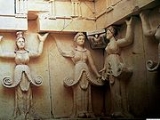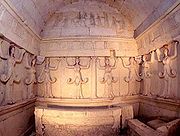
Thracian Tomb of Sveshtari
Encyclopedia
The Thracian Tomb of Sveshtari is situated 2.5 km southwest of the village of Sveshtari, Razgrad Province
, which is located 42 km northeast of Razgrad
, in the northeast of Bulgaria
.
Discovered in 1982 in a mound, this 3rd century BC Thracian
tomb
reflects the fundamental structural principles of Thracian cult buildings. The tomb's architectural decor is considered to be unique, with polychrome half-human, half-plant caryatid
s and painted murals. The ten female figures carved in high relief on the walls of the central chamber and the decorations of the lunette in its vault are the only examples of this type found so far in the Thracian lands. It is a remarkable reminder of the culture of the Getae
, a Thracian people who were in contact with the Hellenistic and Hyperborean worlds, according to ancient geographers.
It has been suggested that it is part of the site of the Getan
city of Helis.

Razgrad Province
Razgrad Province , former name Razgrad okrug) is a province in Northeastern Bulgaria, geographically part of the Ludogorie region. It is named after its administrative and industrial centre - the town of Razgrad...
, which is located 42 km northeast of Razgrad
Razgrad
Razgrad is a city in northeastern Bulgaria, administrative and industrial centre of the homonymous Razgrad Province. As of February 2011, it has a population of 33,238 inhabitants.-History:...
, in the northeast of Bulgaria
Bulgaria
Bulgaria , officially the Republic of Bulgaria , is a parliamentary democracy within a unitary constitutional republic in Southeast Europe. The country borders Romania to the north, Serbia and Macedonia to the west, Greece and Turkey to the south, as well as the Black Sea to the east...
.
Discovered in 1982 in a mound, this 3rd century BC Thracian
Thracians
The ancient Thracians were a group of Indo-European tribes inhabiting areas including Thrace in Southeastern Europe. They spoke the Thracian language – a scarcely attested branch of the Indo-European language family...
tomb
Tomb
A tomb is a repository for the remains of the dead. It is generally any structurally enclosed interment space or burial chamber, of varying sizes...
reflects the fundamental structural principles of Thracian cult buildings. The tomb's architectural decor is considered to be unique, with polychrome half-human, half-plant caryatid
Caryatid
A caryatid is a sculpted female figure serving as an architectural support taking the place of a column or a pillar supporting an entablature on her head. The Greek term karyatides literally means "maidens of Karyai", an ancient town of Peloponnese...
s and painted murals. The ten female figures carved in high relief on the walls of the central chamber and the decorations of the lunette in its vault are the only examples of this type found so far in the Thracian lands. It is a remarkable reminder of the culture of the Getae
Getae
The Getae was the name given by the Greeks to several Thracian tribes that occupied the regions south of the Lower Danube, in what is today northern Bulgaria, and north of the Lower Danube, in Romania...
, a Thracian people who were in contact with the Hellenistic and Hyperborean worlds, according to ancient geographers.
It has been suggested that it is part of the site of the Getan
Getae
The Getae was the name given by the Greeks to several Thracian tribes that occupied the regions south of the Lower Danube, in what is today northern Bulgaria, and north of the Lower Danube, in Romania...
city of Helis.


